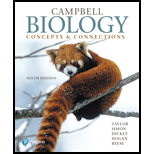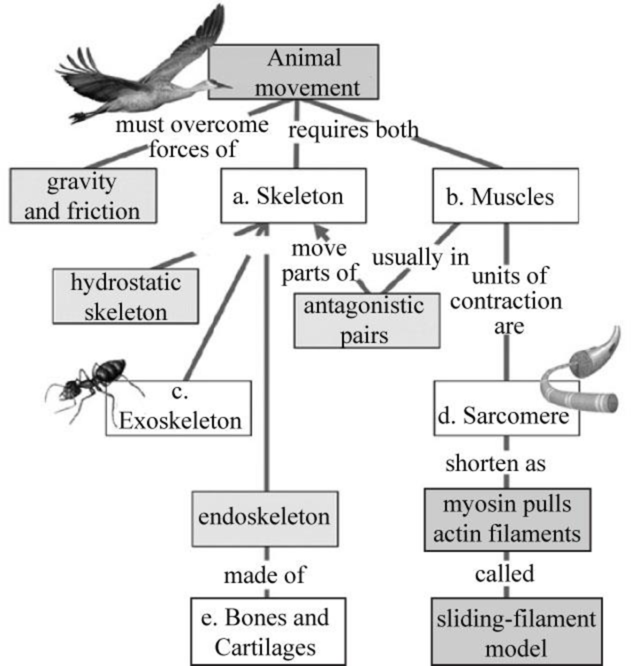
Concept explainers
Complete this concept map on animal movement.

To complete: The given map showing the animal movement.
Introduction:
Movement is a distinguishing characteristic of animals. Even animals that are attached to a substrate move their body parts. All types of animal movement have underlying similarities. At the cellular level, every form of movement involves protein strands moving against one another, an energy-consuming process.
Explanation of Solution
Pictorial representation:
Fig. 1 shows the completed map of the animal movement.

Fig. 1: Completed map of the animal movement
(a)
Correct answer: Skeleton.
Movement in animals requires both the skeleton as well as the muscle. There are many types of skeletons present among the various organisms, which include the endoskeleton, exoskeleton, and hydrostatic skeleton. Each skeleton is associated with different types of movement, such as, flying, walking, running, crawling, and others. Hence, the correct answer is skeleton.
(b)
Correct answer: Muscles.
In every organism, muscles are required to generate a required amount of energy, whether walking, running, swimming, or flying. Hence, the correct answer is muscles.
(c)
Correct answer: Exoskeleton.
The skeletons found among the diverse group of organisms are categorized into three types, which include the endoskeleton, hydrostatic skeleton, and exoskeleton. The exoskeleton is primarily found in the insects. Hence, the correct answer is exoskeleton.
(d)
Correct answer: Sarcomere.
Sarcomeres are the units of muscle contraction; they are found in the striated muscles and are present between 2-Z lines as a repeating unit. Hence, the correct answer is sarcomere.
(e)
Correct answer: Bones and Cartilages.
Endoskeletons are present inside the body and made up of bones and cartilages. Usually, all the vertebrates have a skeleton type as an endoskeleton. Hence, the correct answer is bones and cartilages.
Want to see more full solutions like this?
Chapter 30 Solutions
Campbell Biology: Concepts & Connections (9th Edition)
- 22. Which of the following mutant proteins is expected to have a dominant negative effect when over- expressed in normal cells? a. mutant PI3-kinase that lacks the SH2 domain but retains the kinase function b. mutant Grb2 protein that cannot bind to RTK c. mutant RTK that lacks the extracellular domain d. mutant PDK that has the PH domain but lost the kinase function e. all of the abovearrow_forwardWhat is the label ?arrow_forwardCan you described the image? Can you explain the question as well their answer and how to get to an answer to an problem like this?arrow_forward
- Describe the principle of homeostasis.arrow_forwardExplain how the hormones of the glands listed below travel around the body to target organs and tissues : Pituitary gland Hypothalamus Thyroid Parathyroid Adrenal Pineal Pancreas(islets of langerhans) Gonads (testes and ovaries) Placentaarrow_forwardWhat are the functions of the hormones produced in the glands listed below: Pituitary gland Hypothalamus Thyroid Parathyroid Adrenal Pineal Pancreas(islets of langerhans) Gonads (testes and ovaries) Placentaarrow_forward
 Biology: The Dynamic Science (MindTap Course List)BiologyISBN:9781305389892Author:Peter J. Russell, Paul E. Hertz, Beverly McMillanPublisher:Cengage Learning
Biology: The Dynamic Science (MindTap Course List)BiologyISBN:9781305389892Author:Peter J. Russell, Paul E. Hertz, Beverly McMillanPublisher:Cengage Learning Human Physiology: From Cells to Systems (MindTap ...BiologyISBN:9781285866932Author:Lauralee SherwoodPublisher:Cengage Learning
Human Physiology: From Cells to Systems (MindTap ...BiologyISBN:9781285866932Author:Lauralee SherwoodPublisher:Cengage Learning
 Human Biology (MindTap Course List)BiologyISBN:9781305112100Author:Cecie Starr, Beverly McMillanPublisher:Cengage Learning
Human Biology (MindTap Course List)BiologyISBN:9781305112100Author:Cecie Starr, Beverly McMillanPublisher:Cengage Learning Biology Today and Tomorrow without Physiology (Mi...BiologyISBN:9781305117396Author:Cecie Starr, Christine Evers, Lisa StarrPublisher:Cengage Learning
Biology Today and Tomorrow without Physiology (Mi...BiologyISBN:9781305117396Author:Cecie Starr, Christine Evers, Lisa StarrPublisher:Cengage Learning Biology 2eBiologyISBN:9781947172517Author:Matthew Douglas, Jung Choi, Mary Ann ClarkPublisher:OpenStax
Biology 2eBiologyISBN:9781947172517Author:Matthew Douglas, Jung Choi, Mary Ann ClarkPublisher:OpenStax





